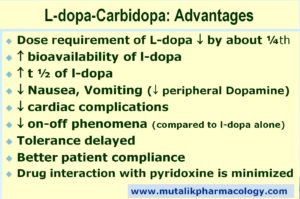Drugs useful in Parkinson
Parkinson or Parkinson-like syndromes may be Idiopathic, Drug-induced or Post-surgical, Post-infective (Post-encephalitic), or Post-traumatic.
Parkinsonism may be associated with dopamine hypoactivity and/or acetylcholine hyperactivity.
So,Pharmacologic Treatment of Parkinson involves two aspects:
- Helping Dopamine
- Blocking Acetylcholine
Special Points
1. Name an anti-parkinson as well as antiviral agent:
Amantadine
2. Drug of choice for drug-induced Parkinson:
Anticholinergics (Atropine Substitutes) and Antihistamines
SAQ/LAQ/Viva
Classify drugs used in Parkinsonism with examples
(A)Drugs affecting Dopamine (DA) system (Dopaminergic system)
- Dopamine presursor: Levodopa
- Peripheral DOPA decarboxylase inhibitors: Carbidopa, Benserazide
- Direct DA agonists: Bromocriptine, Pergolide, Piribedil, Ropinirole, Pramipexole
- COMT inhibitors: Tolcapone, Entacapone
- MAO-B inhibitors: Selegiline
- Dopamine facilitator: Amantadine
(B)Drugs affecting Acetylcholine (Ach) system (Cholinergic system)
- Central anticholinergics: Trihexyphenidyl (Benzhexol), Procyclidine, Biperiden, Benztropine
- H1-Antihistamines: Promethazine, Orphenadrine, Diphenhydramine
[Remember: These drugs – Anticholinergics (Atropine substitutes) and Antihistamines are the drugs of choice for treatment of drug induced Parkinson]
SAQ/Viva
Explain the rationale of using Levodopa-Carbidopa combination in Parkinsonism.
If levodopa is used alone, almost 95% of it gets metabolized in the periphery by the enzyme dopa decarboxylase. Hence very less levodopa is actually available for entry into the brain, and for getting converted into dopamine.
Carbidopa/Benserazide are peripheral dopa-decarboxylase inhibitors. They do not enter the brain, and only peripherally they prevent the breakdown of levodopa into dopamine. So more amount of levodopa is preserved to enter the brain. Thus effectively more levodopa is available to enter the brain and further to get converted into dopamine.
Thus carbidopa / Benserazide increase the bioavailability of levodopa into the brain.
So there is decrease in the dose requirement of levodopa.
Further its dose-related adverse effects are minimized.
And hence the tolerance to levodopa is delayed.
LAQ/SAQ/Viva
Mention the advantages of Levodopa-Carbidopa combination.
Carbidopa is a peripheral dopa-decarboxylase inhibitor. It inhibits the enzyme dopa decarboxylase in the periphery, and inhibits peripheral breakdown of levodopa. So more levodopa is available for entry into brain.
Thus following advantages are expected with levodopa-carbidopa combination:
1. There is increased bioavailability of levodopa into brain and there is an increase in its half life.
2. This reduces the dose requirement of levodopa.
3. Its dose related adverse effects are minimized – Especially the effects due to peripheral dopamine, such as nausea, vomiting, and cardiac complications.
4. Thus lesser dose can be used since the beginning. So, when tolerance begins to show in, there is still comparatively a wider margin for increasing the doses; which means the tolerance to levodopa gets delayed due to addition of carbidopa.
5. The on-off phenomena are decreased.
6. Due to inhibition of peripheral dopa-decarboxylase, there is comparatively lesser effect of the drug interaction with vitamin B6 (Pyridoxine) [Note: The enzyme dopa decarboxylase in pyridoxine dependent]
7. In effect, there is better patient compliance.
[Same advantages are shown in another format below for your revision]

——————————————————————-SAQ/Viva
Mention the problems that are not overcome even after using levodopa-carbidopa combination.
Even after using the levodopa-carbidopa combination, some of the problems (due to levodopa alone) are difficult to overcome. They are:
- Involuntary movements
- Behavioral abnormalities
- Postural hypotension
——————————————————————-Drugs which are known to affect the dopaminergic transmission or block the dopaminergic receptors have a potential of producing Parkinson Like Symptoms. These are various types of involuntary movements also known as extrapyramidal reactions. This phenomenon is called Drug-induced Parkinson. One needs to be careful while prescribing these drugs.
Thank you so much sir for your guidance👍. I am clear with my doubt.
That is great. Keep up the work. You may ask your queries. The discussions help others to learn.
Sir can you plz tell me the disadnvatages of levodopa carbidopa combination.
Good question. Carbidopa is a peripheral dopa-decarboxylase inhibitor, right? So it will concentrate more levodopa in the brain; naturally the adverse effects will be same as those of levodopa – which means the effects due to dopamine concentration in the brain. So its same as adverse effects of levodopa. Please read them.
So I feel YOU PROBABLY WANTED TO ASK what problems while using Levodopa alone are not overcome by the levodopa-carbidopa combination. If it is so – then three problems are not much helped. They remain more or less the same. 1. Behavioral abnormalities such agitation, anxiety, confustion etc. 2. Involuntary movements. 3. Postural hypotension.
As far as per se adverse effects of Carbidopa, if the patient is allergic to it, it may lead to allergic reactions.
All rest adverse effects will be same as mentioned with levodopa.
If you didn;t get it cleared, please tell me here or email on mutalikpharmacology@gmail.com
Thank you sir 🙏